Douglas DC-8 Video - Picture
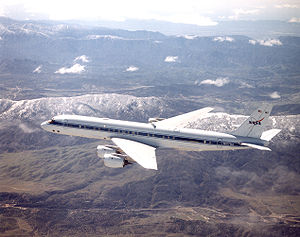
|
|
Douglas DC-8
DC-8

Picture - NASA Dryden DC-8 airborne laboratory refitted with CFM56 turbofan engines
Role: Narrow-body jet airliner
National origin: United States
Manufacturer: Douglas Aircraft
McDonnell Douglas
First flight: May 30, 1958
Introduced: September 1959 with United Airlines and Delta Air Lines
Status: Limited cargo and VIP transport operations
Primary users: Air Transport International
Astar Air Cargo
Johnsons Air
Produced: 1958-1972
Number built: 556
The Douglas DC-8 is a four-engined jet airliner, manufactured from 1958 to 1972 by the Douglas Aircraft Company. Launched later than the competing Boeing 707, the DC-8 nevertheless established Douglas in a strong position in the airliner market, and remained in production until 1972 when much larger designs, including the DC-10 and Boeing 747, made the DC-8 obsolete. Relegated to second-line duties, details of the DC-8 design allowed it to hold slightly more cargo than the 707; dozens of re-engined examples remain in freighter service to this day, while commercial 707 service had largely ended by 2000.
Development
Background
In the post-World War II era, Douglas held a commanding position in the commercial aircraft market. Although Boeing had pointed the way to the modern all-metal airliner in 1933 with the 247, it was Douglas that, more than any other company, had made commercial air travel a reality. Douglas produced a succession of piston-engined aircraft (DC-2, DC-3, DC-4, DC-5, DC-6, and DC-7) through the 1930s, 1940s and 1950s.
When de Havilland introduced the first jet-powered airliner, the Comet, in 1949, Douglas took the view that there was no reason to rush into anything new. Their U.S. competitors at Lockheed and Convair felt the same way: that there would be a gradual switch from piston engines to turbines, and that the switch would be to the more fuel-efficient turboprop engines rather than pure jets. All three companies were working on a new generation of piston-engined designs, with an eye to turboprop conversion in the future.
De Havilland's pioneering Comet entered airline service in 1952. Initially it was a success, but a series of fatal crashes in 1953 and 1954 resulted in the type being grounded until the cause could be discovered. The cause of the Comet crashes had nothing to do with jet engines; it was a rapid metal fatigue failure brought on by cycling the high stresses in corners of the near-square windows from pressurizing the cabin to high altitudes and back. A new understanding of metal fatigue that the Comet investigation produced would play a vital part in the good safety record of later types like the DC-8.
In 1952, Douglas remained the most successful of the commercial aircraft manufacturers. They had almost 300 orders on hand for the piston-engined DC-6 and its successor, the DC-7, which had yet to fly and was still two years away from commercial service. The Comet disasters, and the consequent airline lack of interest in jets, seemed to demonstrate the wisdom of their staying with propeller aircraft.
Competition
In contrast, Boeing took the bold step of starting to plan a pure-jet airliner in as early as 1949. Boeing's military arm had gained extensive experience with large, long-range jets through the B-47 Stratojet (first flight 1947) and the B-52 Stratofortress (1952). With thousands of their big jet bombers on order or in service, Boeing had developed a close relationship with the US Air Force's Strategic Air Command (SAC). Boeing also supplied the SAC's refueling aircraft, the piston-engined KC-97 Stratotankers, but these proved to be too slow and low flying to easily work with the new jet bombers. The B-52, in particular, had to descend from its cruising altitude and then slow almost to stall speed to work with the KC-97, even when the latter was augmented with jet engines to boost its speed.
Believing that a requirement for a jet-powered tanker was a certainty, Boeing started work on a new all-jet aircraft that would fill this role and also be adaptable into an airliner. In the airliner role it would have similar seating capacity to the Comet, but its swept wing planform would give it considerably higher cruising speeds, and better range. First presented in 1950 as the Model 473-60C, Boeing failed to generate any interest at the airlines. Nevertheless, Boeing remained convinced that the project was worthwhile, and decided to press ahead with a prototype, the "Dash-80". After spending $16 million of their own money (~$120 million 2005 USD) on construction, the Dash-80 rolled out on 15 May 1954, and first flew the next month.
Design phase
Boeing's plans became obvious in the industry, in spite of their "code name" intended as a disinformation tactic. Douglas secretly began jet transport project definition studies in mid-1952. By mid-1953 these had developed into a form very similar to the final DC-8; an 80-seat, low-wing aircraft with four Pratt & Whitney JT3C turbojet engines, 30° wing sweep, and an internal cabin diameter of exactly 11 ft (3.35 m) to allow five abreast seating. Maximum weight was to be 95 tons (86 tonnes), and range was estimated to be about 3,000-4,000 mi (4,800-6,400 km).
Douglas remained lukewarm about the jet airliner project, but believed that the Air Force tanker contract would go to two companies for two different aircraft, as several USAF transport contracts in the past had done. In May 1954, the USAF circulated its requirement for 800 jet tankers to Boeing, Douglas, Convair, Fairchild, Lockheed, and Martin. Boeing was already just two months away from having their prototype in the air. Just four months after issuing the tanker requirement, the USAF ordered the first 29 KC-135s from Boeing. Even leaving aside Boeing's ability to supply a jet tanker promptly, the flying-boom air-to-air refueling system - as first fitted to the KC-97 - was also a Boeing product: developing the KC-135 had been a safe bet.
Donald Douglas was shocked by the rapidity of the decision which, he said, had been made before the competing companies even had time to complete their bids. He protested to Washington, but without success. Having started on the DC-8 project, Douglas decided that it was better to press on than give up. Consultations with the airlines resulted in a number of changes: the fuselage was widened by 15 in (38 cm) to allow six-abreast seating. This led to larger wings and tail surfaces and a longer fuselage. The cost of the program was enormous; it was at that time the most expensive venture of any kind ever taken on by a single company. Donald Douglas provided $450 million towards it out of his own pocket.
The DC-8 was officially announced in July 1955. Four versions were offered to begin with, all based on the same 150 ft 6 in (45.9 m) long airframe with a 141 ft 1 in (43 m) wingspan, but varying in engines and fuel capacity, and with maximum weights of about 120-130 tons (109-118 tonnes). Douglas steadfastly refused to offer different fuselage sizes. The maiden flight was planned for December 1957, with entry into revenue service in 1959. Well aware that they were lagging behind Boeing, Douglas began a major push to market the product.
First orders
At the time, Douglas' previous thinking about the airliner market seemed to be coming true; the transition to turbine powered looked likely to be one to turboprops rather than turbojets. The pioneering 40-60-seat Vickers Viscount was already in service and proving enormously popular with both passengers and airlines: it was much faster, quieter and more comfortable than piston-engined types. Another British aircraft, the 90-seat Bristol Britannia, was establishing a fine reputation, and Douglas's main rival in the large, piston-engined passenger aircraft market, Lockheed, had committed to the short/medium range 80-100-seat turboprop Electra, with a launch order from American Airlines for 35 and other major orders flowing in. Meanwhile the Comet remained grounded, the French 90-passenger twin jet Sud Aviation Caravelle prototype had just flown for the first time, and the 707 was not expected to be available until late 1958. The major airlines were reluctant to commit themselves to the huge financial and technical challenge of jet aircraft. On the other hand, no-one could afford not to buy jets if their competitors did.
And there the matter rested until October 1955, when Pan American placed simultaneous orders with Boeing for 20 707s and Douglas for 25 DC-8s. To buy one expensive and untried jet-powered aircraft type was brave: to buy both was at the time, unheard of. In the closing months of 1955, other airlines rushed to follow suit: Air France, American, Braniff, Continental and Sabena ordered 707s; United, National, KLM, Eastern, JAL and SAS chose the DC-8. In 1956 Air India, BOAC, Lufthansa, Qantas and TWA added over 50 to the 707 order book, while Douglas sold 22 DC-8s to Delta, Swissair, TAI, Trans-Canada and UAT. By the start of 1958, Douglas had sold 133 DC-8s as against Boeing's 150 707s.
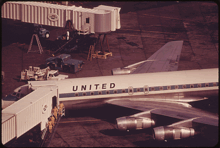
Picture - United Airlines chose the DC-8 over the Boeing 707. This Douglas DC-8-50 was photographed at Boston in 1973.
The first DC-8 was rolled out of the new factory at Long Beach in April 1958 and flew for the first time in May. Later that year, an enlarged version of the Comet finally returned to service, but too late to take a substantial portion of the market: de Havilland had just 25 orders. In October, Boeing began delivering 707s to Pan Am. Douglas made a massive effort to close the gap with Boeing, using no less than ten individual aircraft for flight testing to achieve FAA certification for the first of the many DC-8 variants in August 1959. Much had needed to be done: the original air brakes on the lower rear fuselage were found ineffective and were simply deleted as engine thrust reversers had become available; unique leading-edge slots were added to improve low-speed lift; the prototype was 25 kn (46 km/h) short of its promised cruising speed and a new, slightly larger wingtip had to be developed to reduce drag.
The DC-8 entered revenue service first with Delta Air Lines on 18 September 1959 with United also entering service later on the same day. By March 1960, Douglas had reached their planned production rate of eight DC-8s a month. Despite the large number of DC-8 early models available, all used the same basic airframe, differing only in engines, weights and details. In contrast, Boeing's rival 707 range offered several fuselage lengths and two differing wingspans: the original 144 ft (44 m) 707-120, a 135 ft (41 m) version that sacrificed space to gain longer range, and the stretched 707-320, which at 153 ft (46.5 m) overall had 10 ft (3 m) more cabin space than the DC-8. Douglas' refusal to offer different fuselage sizes made it less adaptable, and the DC-8 gradually lost market share to Boeing. After an excellent start, 1962 DC-8 sales dropped to just 26, followed by 21 in 1963 and 14 in '64, and most of these were for the Jet Trader rather than the more prestigious passenger versions. In 1967, Douglas merged with McDonnell Aircraft Corporation to become McDonnell Douglas (MDC).
On 21 August 1961 a Douglas DC-8 broke the sound barrier at Mach 1.012 (660 mph/1,062 km/h) while in a controlled dive through 41,000 ft (12,497 m). The flight was to collect data on a new leading-edge design for the wing. The DC-8 became the first civilian jet to make a supersonic flight. The aircraft was a DC-8-43 later delivered to Canadian Pacific Air Lines as CF-CPG.
Further developments
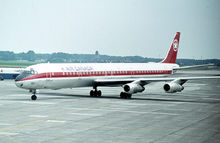
Picture - Air Canada DC-8-61 at Montréal-Pierre Elliott Trudeau International Airport
In April 1965, Douglas announced belated fuselage stretches for the DC-8, with not just one but three new models, known as the Super Sixties. The DC-8 program had been in danger of closing with fewer than 300 aircraft sold, but the Super Sixties brought fresh life to it. By the time production ceased in 1972, 262 of the stretched DC-8s had been made. With the ability to seat 269 passengers, the DC-8 Series 61 and 63 easily comprised the largest airliner available, and remained so until the Boeing 747 arrived in 1970.
All the earlier jetliners were noisy by modern standards. Increasing traffic densities and changing public attitudes led to complaints about aircraft noise and moves to introduce restrictions. As early as 1966 the New York Port Authority expressed concern about the noise to be expected from the then still unbuilt DC-8-61, and operators had to agree to operate it from New York at lower weights to reduce noise. By the early 1970s, legislation for aircraft noise standards was being introduced in many countries, and the 60 Series DC-8s were particularly at risk of being banned from major airports.
In the early 1970s several airlines approached McDonnell Douglas for noise reduction modifications to the DC-8 but nothing was done. Third parties had developed aftermarket hushkits but there was no real move to keep the DC-8 in service. Finally, in 1975, General Electric began discussions with major airlines with a view to fitting the new and vastly quieter Franco-American CFM56 engine to both DC-8s and 707s. MDC remained reluctant but eventually came on board in the late 1970s and helped develop the 70 Series DC-8s.
The Super Seventies were a great success: roughly 70% quieter than the 60-Series and, at the time of their introduction, the world's quietest four-engined airliner. As well as being quieter and more powerful, the CFM56 was roughly 20% more fuel efficient than the JT3D, which reduced operating costs and extended the range.
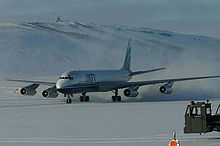
Picture - Air Transport International DC-8-62F at Thule AB, Greenland.
By 2002, of the 1032 707s and 720s manufactured for commercial use, just 80 remained in service - though many of those 707s were converted for USAF use, either in service or for spare parts. Of the 556 DC-8s made, around 200 were still in commercial service in 2002, including about 25 50-Series, 82 of the stretched 60-Series, and 96 out of the 110 re-engined 70-Series. Most of the surviving DC-8s are now used as freighters. As of May 2009, 97 DC-8s were in service following UPS's decision to retire their remaining fleet of 44.
Variants
Early models
DC-8 Series 10 For U.S. domestic use and powered by 13,601 lbf (60.5 kN) Pratt & Whitney JT3C-6 turbojets. The initial DC-8-11 model had the original, high-drag wingtips and all examples were subsequently converted to DC-8-12 standard. The DC-8-12 had the new wingtips and leading-edge slots inboard of each pylon. These unique devices were actuated by doors on the upper and lower surfaces that opened for low speed flight and closed for cruise. The maximum weight increased from 132 tons (120 tonnes) to 136 tons (123 tonnes). 28 DC-8-10s were manufactured. This model was originally named "DC-8A" until the series 30 was introduced.
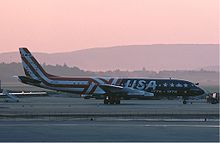
Picture - DC-8-32 of Overseas National Airways in Zurich, 1975
DC-8 Series 20 Higher-powered 15,916 lbf (70.8 kN) Pratt & Whitney JT4A-3 turbojets allowed a weight increase to 138 tons (125 tonnes). 34 DC-8-20s were manufactured. This model was originally named "DC-8B" but was renamed when the series 30 was introduced.
DC-8 Series 30 For intercontinental routes, the three Series 30 variants combined JT4A engines with a one-third increase in fuel capacity and strengthened fuselage and landing gear. The DC-8-31 was certified in March 1960 with 16,906 lbf (75.2 kN) JT4A-9 engines for 150 tons (136 tonnes) maximum weight. The DC-8-32 was similar but allowed 154 tons (140 tonnes) weight. The DC-8-33 of November 1960 substituted 17,625 lbf (78.4 kN) JT4A-11 turbojets, a modification to the flap linkage to allow a 1.5° setting for more efficient cruise, stronger landing gear, and 158 tons (143 tonnes) maximum weight. Many -31 and -32 DC-8s were upgraded to this standard. A total of 57 DC-8-30s were produced.
DC-8 Series 40 The first turbofan-powered airliner in the world, with delivery in 1960. The -40 was essentially the same as the -30 but with 17,625 lbf (78.4 kN) Rolls-Royce Conway turbofans for better efficiency, less noise and less smoke. The Conway was a significant improvement over the turbojets that preceded it, but the Series 40 sold poorly both because of the traditional reluctance of U.S. airlines to buy a foreign product and because the still more advanced Pratt & Whitney JT3D turbofan was due in early 1961. The DC-8-41 and DC-8-42 had weights of 150 tons (136 tonnes) and 154 tons (140 tonnes), the 158 ton (143 tonne) DC-8-43 had the 1.5° flap setting of the -33 and introduced a new 4% leading edge wing extension to allow a small fuel capacity increase and a significant drag reduction - the new wing design improved range by 8%, lifting capacity by 3.3 tons (3 tonnes), and cruising speed by better than 10 kn (19 km/h). It would be included in all future DC-8s. A total of 32 DC-8-40s were manufactured.
DC-8 Series 50 The definitive short-fuselage DC-8 with the same engine that powered the vast majority of 707s, the JT3D. Many earlier DC-8s were converted to this standard. All bar the -55 were certified in 1961. The DC-8-51, DC-8-52 and DC-8-53 all had 17,108 lbf (76.1 kN) JT3D-1 or 18,120 lbf (80.6 kN) JT3D-3B engines, varying mainly in their weights: 139, 152 and 157 tons (126, 138 and 142 tonnes) respectively. The DC-8-55 arrived in June 1964, retaining the JT3D-3B engines but with strengthened structure from the freighter versions and 147 tonne maximum weight. 88 DC-8-50s were manufactured.
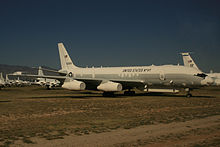
Picture - The unique EC-24A of the US Navy in storage
DC-8 Jet Trader Douglas approved development of specialized freighter versions of the DC-8 in May 1961, based on the Series 50. An original plan to fit a fixed bulkhead separating the forward â…” of the cabin for freight, leaving the rear cabin for 54 passenger seats was soon replaced by a more practical one to use a movable bulkhead and allow anywhere between 25 and 114 seats with the remainder set aside for cargo. A large cargo door was fitted into the forward fuselage, the cabin floor was reinforced and the rear pressure bulkhead was moved by nearly 7 ft (2 m) to make more space. Airlines were offered the option of a windowless cabin, though only one, United, took this up, with an order for 15 in 1964. The DC-8F-54 had a maximum takeoff weight of 158 tons (143 tonnes) and the DC-8F-55 162 tons (147 tonnes). Both used 18,120 lbf (80.6 kN) JT3D-3B powerplants.
C-24 A single ex-United Airlines DC-8F-54 was used by the United States Navy as an electronic warfare training platform. Given the designation EC-24A, it was retired in October 1998 and is now in storage with the 309th Aerospace Maintenance and Regeneration Group.
Super sixties
The DC-8 Series 61 was designed for high capacity and medium range. It had the same wings, engines and pylons as the -53, and sacrificed range to gain capacity. Having decided to stretch the DC-8, Douglas inserted a 20 ft (6 m) plug in the forward fuselage and a 16 ft (5 m) plug aft, taking overall length to 187 ft (57 m) and giving the aircraft a very long, lean look that was (and is still) unique. Bending forces required strengthening of the structure, but the basic DC-8 design already had sufficient ground clearance to permit the one-third increase in cabin size without requiring longer landing gear. It was certified in September 1966 and typically carried 210 passengers, or 269 in high-density configuration. A total of 88 were sold.
Timelines: First flight: March 14, 1966. FAA certification: September 2, 1966. First delivery: January 26, 1967 United Airlines. Entry into Service: February 25, 1967 United Airlines.
The long-range DC-8 Series 62 followed in April 1967. It had a much more modest stretch of just 6 feet 6 inches (1.98 m) (with 3 feet 3 inches (0.99 m) plugs fore and aft), the more powerful JT3D-7 engines as the -63, and a number of modifications to provide greater range. 3 feet (0.91 m) wingtip extensions reduced drag and added fuel capacity, and Douglas redesigned the engine pods, extending the pylons and substituting new shorter and neater nacelles, all in the cause of drag reduction. The engine pylons were redesigned to eliminate their protrusion above the wing and make them sweep forward more sharply, so that the engines were actually positioned some 40 inch further forward. The engine pods were also modified featuring a reduction in pod diameter and the elimination of the -50 and -61 bypass duct. The changes all contributed to improve the aircraft's aerodynamic efficiency. The DC-8 Series 62 is slightly heavier than the -53 or -61 at 166 tons (151 tonnes), and able to seat 159 passengers, the -62 had a range with full payload of about 5,200 nmi (9,600 km), or about the same as the -53 but with 40 extra passengers. A total of 67 were built.
Timelines:
First flight: August 29, 1966.
FAA certification: April 27, 1967.
First delivery: May 5, 1967 Scandinavian Airlines (SAS).
Entry into Service: May 22, 1967 Scandinavian Airlines (SAS).
The DC-8 Series 63 was the final new build variant and entered service in June 1968. It combined the long fuselage of the -61 with the aerodynamic refinements, increased fuel capacity, and JT3D-7 turbofans of the -62. This yielded a maximum take off weight of almost 175 tons (159 tonnes) and a range with full payload of 4,110 nmi (7,600 km). A total of 107 were built, a little over half of them convertibles or dedicated freighters.
Timelines:
First flight: April 10, 1967.
FAA certification: June 30, 1967.
First delivery: July 15, 1967 KLM.
Entry into Service: July 27, 1967 KLM.
Last delivery: May 1972 Scandinavian Airlines (SAS).
Super seventies
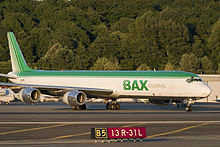
Picture - BAX Global DC-8-71(F) at Boeing Field
The DC-8-72 and the DC-8-73 were straightforward conversions of the -62 and -63, replacing the JT3D engines with 22,144 lbf (98.5 kN) CFM56-2 high-bypass turbofans in new housings built by Grumman. The DC-8-71 achieved the same end but required considerably more modification because the -61 did not already have the improved wings and relocated engines of the -62 and -63. Maximum takeoff weights remained the same, but there was a slight reduction in payload because of the heavier engines. All three models were certified in 1982 and a total of 110 60-Series DC-8s were converted by the time the program ended in 1988.
Operators
A total of 84 DC-8 aircraft (all variants) were in commercial service as of July 2010; the following operators had two or more aircraft in inventory:
UPS Airlines (25)
Air Transport International (17)
Astar Air Cargo (8)
Meridian Airways (5)
BETA Cargo (4)
Expo Aviation (1)
National Airlines (4)
The DC-8 is no longer used by military organizations as of 2008. The DC-8 is in use by NASA as an Airborne Laboratory.
Accidents and incidents
As of August 2008, the DC-8 had been involved in 139 incidents, including 83 hull-loss accidents, with 2,256 fatalities.
Notable accidents
On December 16, 1960, United Airlines Flight 826, a DC-8, collided with a TWA Lockheed Constellation (as Flight 266) in mid-air over Staten Island, New York City, New York, United States, resulting in a total of 134 fatalities.
On May 30, 1961, Viasa Flight 897, a DC-8, crashed into the Atlantic Ocean shortly after takeoff from Lisbon Portela Airport. All 61 passengers and crew on board were killed.
On August 20, 1962, a Panair do Brasil DC-8-33, registration PP-PDT flying from Rio de Janeiro - Galex£o to Lisbon, overran the runway into the ocean during an aborted take-off. Of the 105 passengers and crew aboard, 15 died.
On November 29, 1963, Trans-Canada Air Lines Flight 831, a DC-8, crashed shortly after takeoff from Montréal/Dorval Airport, killing all 118 people on board.
On February 25, 1964, Eastern Air Lines Flight 304, a DC-8 flying from New Orleans International Airport to Washington National Airport crashed into Lake Pontchartrain killing all 51 passengers and 7 crew aboard. The cause was determined to be related to an abnormal trim setting resulting in aircraft instability.
On March 4, 1966, Canadian Pacific Airlines Flight 402 (CP402), a DC-8-43 crashed on landing at Tokyo International Airport in Japan, killing 64 passengers and crew; 8 passengers survived.
On March 5, 1967, Varig Airlines Flight 837, a DC-8-33 hit buildings while on the approach to Monrovia Airport, Liberia. Of the 71 passengers and 19 crew on board, 66 passengers and one crew member (the flight engineer) were killed. The DC-8-33 was on a scheduled flight from Beirut to Rio de Janeiro via Rome and Monrovia. Five persons on the ground were also killed.
On July 1, 1968, Seaboard World Airlines Flight 253, a DC-8, was forced to land in the Soviet Union. Onboard were over 200 American troops bound for Vietnam.
On January 13, 1969, Scandinavian Airlines Flight 933, a DC-8, crashed into the Pacific Ocean west of Los Angeles International Airport. Of the 36 passengers and 9 crew aboard, 15 were killed in the crash.
On July 5, 1970, Air Canada Flight 621, a DC-8-63, exploded near Toronto Pearson International Airport, with 109 fatalities, when premature deployment of the wing spoilers caused an engine to detach, igniting onboard fuel during the subsequent go around.
On May 5, 1972 Alitalia Flight 112, a DC-8-43, crashed into a mountain in the outskirts of Palermo and disintegrated, killing all 115 people on board (108 passengers and 7 crew).
On November 27, 1972, Japan Airlines Flight 446, a DC-8-62, crashed while in an initial climb on a route from Sheremetyevo International Airport of Moscow to Haneda Airport. 9 of 14 crew members and 52 of 62 passengers died, with a total of 61 of 76 occupants dead.
On 4 December 1974, Martinair Flight 138, flew into the side of a mountain while on landing approach in Colombo, Sri Lanka. All 191 passengers and crew on board were killed.
On 24 December 1972, Japan Airlines Flight 472, operated Douglas DC-8-53 landed at Juhu Aerodrome instead of Santacruz Airport. The aircraft overran the end of the runway and was damaged beyond economic repair.
On October 6, 1976, Cubana Flight 455, a DC-8, was bombed by anti-Castro terrorists and crashed near Bridgetown, Barbados, killing all 73 people on board.
On September 27, 1977, Japan Airlines Flight 715, a DC-8, crashed into a hill as the aircraft was on approach into Sultan Abdul Aziz Shah Airport, Malaysia. The accident killed 34 out of 79 passengers and crew on board.
On September 28, 1977, Japan Airlines Flight 472, a DC-8, was hijacked after taking off from Mumbai, India by Japanese Red Army (JRA) terrorists. The terrorists forced the airplane to land in Dhaka, Bangladesh, where they demanded US$6 million and the release of nine imprisoned JRA members being held in Japan. The Japanese government complied and all of the hostages were eventually released.
On November 15, 1978, Icelandic Airlines Flight LL 001, a DC-8 on a charter flight, crashed into a coconut plantation while on approach to Katunayake, Sri Lanka for a refueling stop. 184 out of 264 people on board were killed.
On December 28, 1978, United Airlines Flight 173, a DC-8, ran out of fuel while circling near Portland, Oregon, United States while the crew investigated a light indicating a problem with the landing gear. The airplane crashed in a wooded area, killing 10 and injuring 24 of the 181 on board.
On February 9, 1982, Japan Airlines Flight 350, a DC-8-61, crashed on approach to Tokyo International Airport (Haneda). Among the 166 passengers and 8 crew, 24 passengers were killed.
On December 12, 1985 Arrow Air Flight 1285, a DC-8, crashed after takeoff in Gander, Newfoundland, killing all 256 passengers and crew on board, making it the worst air disaster to occur in Canada; the cause was determined to be a stall most likely due to wing icing.
On June 7, 1989, Surinam Airways Flight PY764, a DC-8, crashed while attempting to land in heavy fog at Paramaribo, Suriname. The plane hit trees and flipped upside down, killing 176 of 187 people on board.
On July 11, 1991, Nigeria Airways Flight 2120, a Nationair DC-8-61 chartered by Nigeria Airways to transport Nigerian pilgrims to Mecca, crashed shortly after takeoff from Jeddah, Saudi Arabia, due to a fire caused by tire failure. All 261 on board died, including 14 Canadian crew members.
Related development
Douglas DC-9
Comparable aircraft
Boeing 707
de Havilland Comet
Convair 990
Ilyushin Il-62
Shanghai Y-10
Tupolev Tu-114
Vickers VC10
Further reading
Cearley, George Walker. The Douglas DC-8: A Pictorial History. Dallas: G.W. Cearley, Jr., 1992.
Douglas Aircraft Co. The DC-8 Story. Long Beach, CA: Douglas Aircraft Company, 1972.
Francillon, René. McDonnell Douglas Aircraft Since 1920: Volume I. London: Putnam, 1979. ISBN 0-87021-428-4.
McDonnell-Douglas. The DC-8 Super-Sixty. Long Beach, CA: McDonnell Douglas Corp. Sales Engineering Div., 1968.
McDonnell-Douglas. The DC-8 Handbook. Long Beach, CA: McDonnell Douglas Corp. Sales Engineering Div., 1982.
Waddington, Terry. Douglas DC-8. Miami, FL: World Transport Press, 1996. ISBN 0-96267305-6.
Wilson, Stewart. Airliners of the World. Fyshwick, Australia, ACT: Aerospace Publications Pty Ltd., 1999. ISBN 1-875671-44-7.
Wilson, Stewart. Boeing 707, Douglas DC-8, and Vickers VC-10. Fyshwick, Australia, ACT: Aerospace Publications Pty Ltd., 1998. ISBN 1-875671-36-6.
Douglas DC-8 Pictures
More aircraft.
Source: WikiPedia